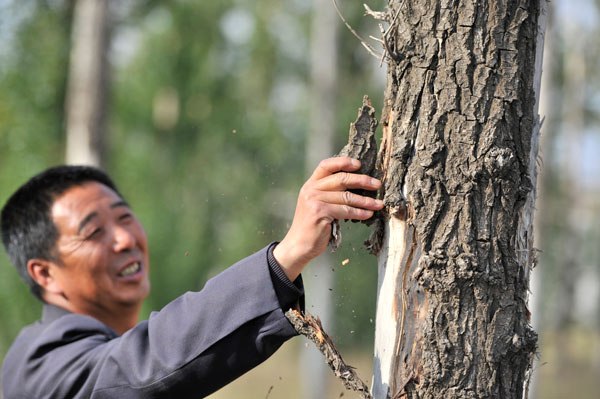

Zhang Shaoyun, 53, a ranger at a forest in Zhangjiakou, Hebei province, easily rips off a piece of bark from a dead poplar tree. The poplars began withering at the forestry farm in September. The forest was planted to act as a shield against sandstorms. Jiang Guidong / for China Daily
A forest planted decades ago to prevent sandstorms from hitting northern China is in a severe state of decay.
The tree line covers more than 102,000 hectares of northern Zhangjiakou, a city in Hebei province about 200 kilometers from the capital.
According to forestry officials, 92 percent of the poplars last year were "hypermature", meaning they have been decaying for a decade. A third of the forest is dead or dying and 48,800 hectares are growing poorly.
Many trees are bare and weak, said Zhang Shaoyun at Zhangbei county's Central Forest Farm.
"The bark can easily be torn off, and a man could even push one over," said the ranger of 32 years. "The decaying trees have spread quickly, and tens of thousands of trees are withering every year, leaving few left."
The vast forest was first planted in the city's Bashang area in 1967, with the aim of sheltering Beijing from sands blown from the north and west.
In Zhangbei, the number of days of heavy wind dropped from more than 90 in 2002 to about 30 last year. Sandstorms hit on only four to six days, compared with 26 a decade earlier.
However, the withering forest — part of northern China's network of shelterbelts — is proving less effective, meaning cities face an increased risk of sandstorms.
The decay "will definitely impact the cities downwind, including Beijing", predicted Wang Jinhuan, deputy director of Zhangjiakou forestry bureau.
According to national standards, the poplars that have stood in northern China for more than 30 years are hyper-mature.
"Frequent drought and barren soil have also accelerated the process," Wang said.
A report on the city's water sector also showed that the protective forest has witnessed a continuous decline in underground water levels, dropping at least 1 meter a year between 2000 and 2010.
"Another important reason for the decaying green belts is that the tending operation has fallen behind," Wang said.
The farm, as well as the county and city governments, attributed the insufficient maintenance to a lack of allocation.
Public forests are forbidden by law from tree felling to protect the environment.
Sandstorm, thunderstorm lash Bohu, NW China's Xinjiang
2013-04-19Sandstorm worsening air pollution
2013-03-08Copyright ©1999-2018
Chinanews.com. All rights reserved.
Reproduction in whole or in part without permission is prohibited.